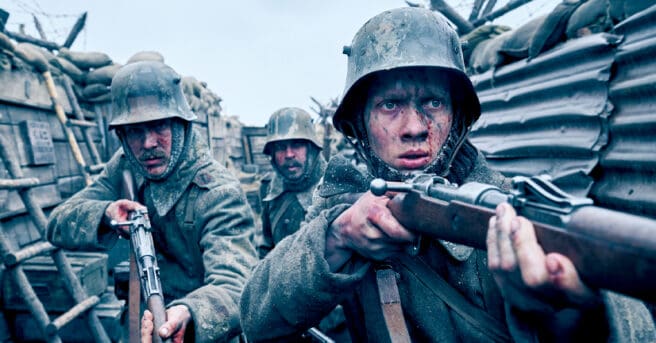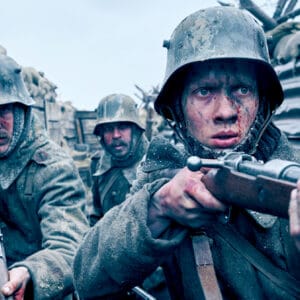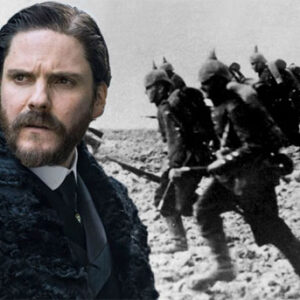PLOT: In this updated version of the classic WWI story, a German schoolboy named Paul (Felix Kammerer) and his school friends enlist in the army, only to find themselves to be little more than cannon fodder as the war goes on and on, without an end in sight.
REVIEW: For those unaware, the 1930 version of All Quiet on the Western Front was widely acclaimed in its day, winning the best picture and best director Oscars, but also making history as the first film to win the top prizes having been based on a book (written by Erich Maria Remarque). It was also wildly controversial, with the Nazis famously letting rats loose in theatres that dared play it in Germany. Its anti-war message meant that re-releases of the film were severely cut – although the current version is fully restored to what the director (Lewis Milestone) originally intended.
Being a film that’s ninety-two years old and was one of the early talkies, it’s a bit creaky nowadays, mainly due to the pantomime style of acting given that it was the early days of sound. This new version of All Quiet on the Western Front is anything but creaky. Using Remarque’s book and the 1930 film as a jumping-off point, director Edward Berger has made a visceral anti-war experience that, along with Sam Mendes’ recent 1917, fully immerses the viewer into the hell of trench warfare in ways previous films never did. It’s also the first German-language film version of Remarque’s novel.
The novel this is based on is a slim volume. Berger’s film expands the story to be an epic exploration of Germany’s role in WWI, particularly the divide between the aristocratic Prussian generals and the working class soldiers they send to their graves by the millions. We also follow real-life German historical figure Matthias Erzberger (Daniel Brühl) as he tries to negotiate for peace but is stifled by the pride of the generals and the desire by France not only to claim victory but also humiliate their opponent, ultimately helping to pave the way for the tragedy of WWII.
Most of the film, though, follows the journey of German soldier Paul from being a wide-eyed schoolboy eager for the adventure of war to a hard-bitten soldier with a death wish. Felix Kammerer delivers a stunning performance, evoking Paul’s naivete and fear early on to his eventual disillusionment and fatalism in a way no other actor has ever managed. Berger helps him by staging some bravura sequences, such as a scene at the beginning where we see a young soldier die only to be stripped naked so that his uniform can be patched up and re-used, eventually given to Paul.

The battle scenes are on par with anything seen in Sam Mendes’ 1917, with one massive sequence involving tanks and flamethrowers ranking among the harrowing scenes of up-close-and-personal trench warfare I’ve seen in the genre since Saving Private Ryan. In addition to Kammerer, the film also has an excellent performance by Albrecht Schuch as “Kat” Katczinsky, the much older soldier who takes Paul under his wing and teaches him how to survive. He’s depicted as the only one who cares if any of these boys live or die, with him taking on a brotherly (or even fatherly) role in the squad, even though at the end of the day, he’s just a recruit like them.
Berger’s working with a big budget here, with Netflix pulling out all of the stops to make this genuinely epic. While bound for the streamer, it played well on the big screen at TIFF, where it was incredibly immersive. The terrific score by composer Hauschka was impressive, with jarring industrial synth notes especially effective at underscoring the horror of what we see on-screen.
All Quiet on the Western Front will hit Netflix this fall, and it’s certainly one to keep an eye out for. Typically, WWII is the war most often given the epic treatment. Still, WWI was the first “total war” and has rarely been depicted so effectively – especially not from the German side. Remarque’s story has always been one of the great anti-war tales, and time has certainly not dulled its power.




















Follow the JOBLO MOVIE NETWORK
Follow us on YOUTUBE
Follow ARROW IN THE HEAD
Follow AITH on YOUTUBE